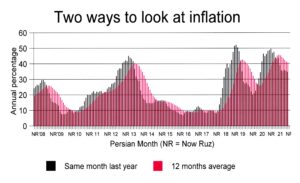May 20, 2022

However, the World Bank says its forecast is not much to crow about. It calls the new growth estimate only “modest.”
Furthermore, that means growth this year will be less than growth in the last Persian year, which the World Bank put at 4.1 percent. (The IMF put last year’s growth at 4.0 percent.)
The Worldl Bank said last year’s growth was propelled largely by improved oil sales. But the overall growth was dragged down by a poor performance from industry—which Supreme Leader Ali Khamenehi has insisted for three years must be the main propellant of growth (and self-sufficiency) and by a disastrous decline in agricultural output due to a shortage of water and energy supplies.
What’s more, the labor picture is bleak, says the World Bank. “The recovery [of last year] was largely driven by the oil sector [which employs few people], and employment growth in services and industries could not compensate for job losses in the agriculture sector.”
But what impacts the public most is the long-term trends. And that’s where the World Bank report was gloomiest, saying Iran has marched both up and down over the last 16 years but has ended up just where it began, with no overall gain whatsoever.
In the technical language of the World, Bank, it said, “Real GDP in 2020-21 [the Persian year 1399] was almost at the same level as 2010-11, and real GDP per capita in 2020-21 fell to the 2004-05 level.”
While the World Bank and IMF are both estimating lower GDP growth this year than last year, they are also both forecasting even lower growth in 2023-24 (2.7 percent from the World Bank and 2 percent from the IMF). And the World Bank forecasts even lower growth in 2024-25 (2.3 percent).
Of course, the longer-term outlook is heavily dependent on the outcome of the nuclear talks with the United States. If they succeed, Iran almost certainly will see much higher oil sales. But, if they fail, Washington is expected to go all-out to enforce sanctions, which will throttle oil exports even further.
In its overall assessment of Iran, the World Bank says, “The economy remains constrained by widespread inefficiencies and price distortions that have contributed to the economy’s performance.” The World Bank has urged Iran to make numerous reforms to reduce those inefficiencies and distortions, but the Islamic Republic has done next-to-nothing to adopt those proposals.
The World Bank report concluded with these observations. “Average GDP growth is projected to remain modest in the medium term as the economy remains constrained by the continued impact of the pandemic through weaker domestic and global demand, while trade, especially oil exports, remains restricted by ongoing sanctions. Iran’s economic outlook is subject to significant risks. On the upside, further increase in oil prices can directly boost fiscal revenues and indirectly lead to a faster growth in oil export volumes. Downside risks relate to the resurgence of new COVID-19 variants, worsening climate change impact, and heightened geopolitical tensions, including the war in Ukraine’s impact on global food prices and Iran’s imports.”